What’s worse than having a travel blog with no traffic?
A travel blog WITH traffic that doesn’t convert into leads and sales.
Don’t feel bad about selling. You’re helping out your readers by promoting relevant products and services on your website!
Having great products to promote as an affiliate makes all the difference.
When it comes to travel affiliate programs, volume is the name of the game. Most travel products offer a small but respectable reward for a referral.
And despite relatively low commissions, you don’t need a website that’s doing 100,000 hits a month to generate a decent income.
In fact:
Small blogs targeting specific niche’s, generally attract higher-quality traffic compared to larger sites offering more generic advice.
And higher-quality targeted traffic = more conversions.
Related: What Is Affiliate Marketing & How Does It Work?
A Fast-Growing Ever-Green Niche
The travel industry has enjoyed steady growth for a number of years.
The obligatory stats:
- The number of international tourists has doubled from 585 million in 2005 to over 1.19 Billion back in 2015.
- Travel industry revenue is expected to grow 10.9% over the next four years, producing $957 billion by 2021.
- More people switching from offline to online travel booking. As many as 76% of people are now booking their holidays online, according to ABTA.
This is great news for travel affiliates!
The travel industry is great for affiliate marketers and ranked fourth in a study on the best affiliate programs by AMNavigator. The study ranked affiliate programs through KPI’s like earnings per click, conversion rate and payout volume.
After analysing 550 affiliate programs across 6 networks, they put together the following affiliate category graph:
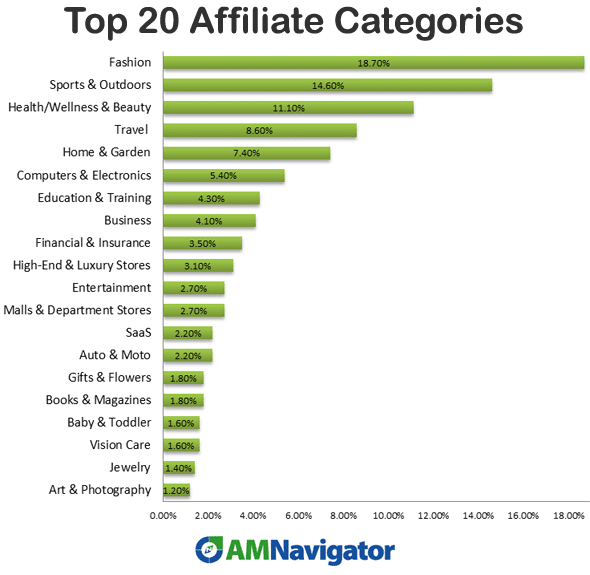
Travel Giants Dominating the Industry
The travel industry is dominated by a few key players. These mighty brands generate millions of website visitors every month.
While the size of a business certainly doesn’t measure success, it’s useful to know who the big players are in this game.
The following chart displays monthly organic traffic data for the titans of the travel industry. It’s worth noting that the link analysis tool I used (Ahrefs) usually underestimates traffic data.
So the true numbers could be much higher:
This simple chart doesn’t take into account PPC or social media referral traffic but it provides useful insight into the brands that dominate the travel industry.
How Much can Bloggers Actually Make through Travel Affiliate Programs?
While affiliate programs in travel won’t net you huge commissions for each sale, bloggers send the highest amount of referral traffic to advertisers.
Over 65% in some cases, according to research done by Travel Payouts.
A quick look at the popular domain marketplace, Flippa, tells us how much monthly revenue some travel blogs are making.
For example — a simple holiday rental affiliate site making $20k per year was recently sold on Flippa for $50k:

Some more examples of small affiliate sites generating passive income:
(These sites were still under auction at the time of writing)

“Travelguideunlimited.com“ is a bog-standard blog providing tips on all things travel-related.
It attracts just over 8000 hits a month and generates revenue primarily through the Amazon Associates program (interestingly, not a great affiliate program) as well as banner ad sales. This is a site that has only been around since January 2017!
“The Constant Rambler“ is a travel blog that posts reviews, animal travel tips and road trip plans. It generates 27,000 hits a month (with a large portion coming from organic SEO) and primarily makes money from display ads and affiliate sales.
Notice that the second website attracts way more visitors but still makes less money?
This could be due to lack of money-producing content or conversion optimisation on the blog. Or perhaps they’re promoting products with low commission payouts from low-quality affiliate networks such as Clickbank.
These examples demonstrate that you don’t need a crazy amount of traffic to make money blogging.
Let’s compare the above sites with a titan in the world of travel blogging:
The Poor Traveler
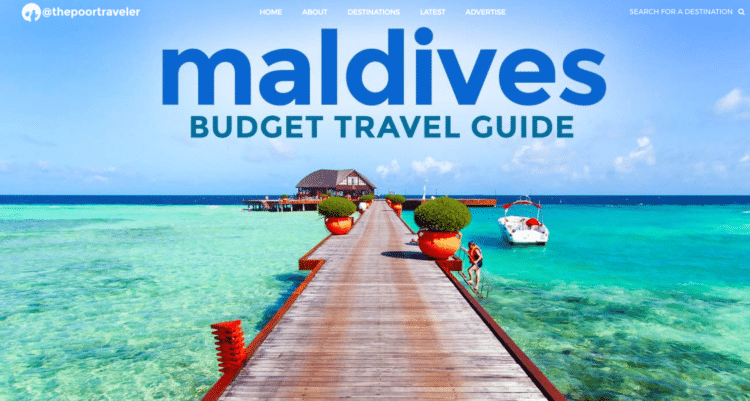
The poor traveler is a website owned by two guys from the Philippines:
Yoshke and Vins.
These two started off being stuck in a corporate cubicle and slowly grew their blog from nothing into one of the largest travel blogs in the world.
They dominate search terms in the Philippines for many travel-related keywords.
According to Ahrefs, The Poor Traveler is doing over 138,000 hits from organic search every month!
Bearing in mind that most of these are coming from the Philippines so the buying power isn’t as strong. That said, they look to be doing upwards of $40,000 USD a month. And It could well be much more than that.
Their highest ranking articles are monetised through booking buttons from Agoda.
A typical post would be a “Top 10” list with a “check rates & availability” button for each that sends the visitor to the merchant website…
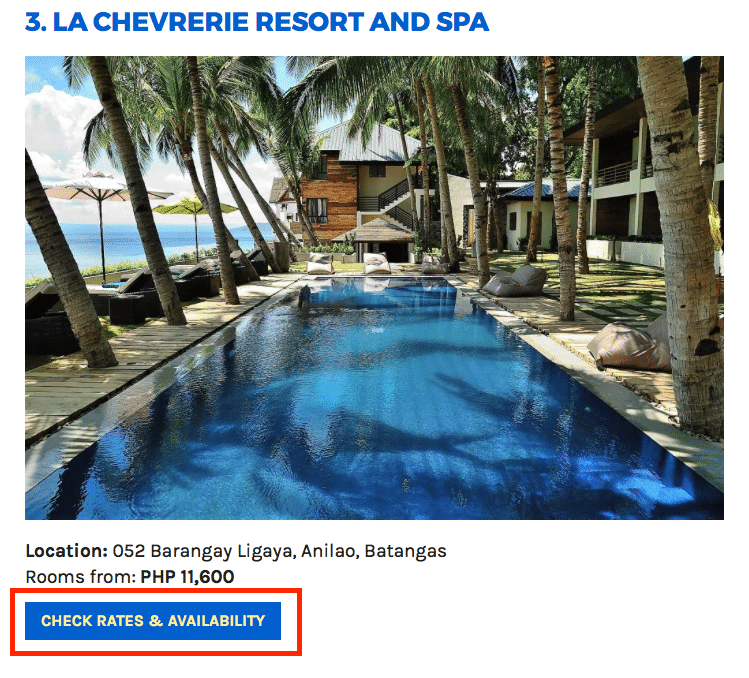
Their content isn’t amazing either, but with patience and dedication, they’ve built an asset that has enabled them to quit their day jobs and live life on their own terms.
Three Keys to a Thriving Travel Blog
Three important elements form the bedrock of any successful affiliate site. Identifying and understanding these elements will skyrocket your earning potential.
1. Product Promotion
I’m sure you’ve heard the age-old saying “you’re the average of the five people you spend time with” — well, the same applies to your blog!
Your blog is the average of the five products you promote. People associate your site with the resources you promote and references in your articles.
Unsatisfactory products = tarnished brand reputation.
Branding is becoming increasingly important for websites monetised through affiliate marketing. Why? Because a strong site identity helps separate you from the competition.
None of us like a faceless corporation and the same applies to generic affiliate sites with poor content.
To find the best affiliate products, research ones that align with your core values. You might get paid less at the start but you’ll be rewarded in the form of increased trust and authority in the long run.
Market Segmentation
A fancy word for finding your angle.
What sort of content are you going to focus on?
Market segmentation is where keyword research comes into play.
You want to focus on keywords that have high search volume and medium to low competition. Avoid keywords like “Hotels in London” because the likes of Trip Advisor, Hotels.com and Expedia totally dominate the first page of Google for these terms.
I spent a few minutes doing some keyword research and found some awesome low-hanging fruit examples:

“Luggage sets” is a particularly juicy keyword with massive search volume and low competition. A quick look on the SERP’s threw up a bunch of generic “Luggage sets” headlines from various websites.
A “top x” list post and some clever promotion could bring you to the first page for that keyword.
The keywords above can be framed in various ways for a niche website.
You could:
- Create a blog that specialises in finding the best hotels on the Greek islands.
- Start a blog centred around holiday planning, providing resources that help people do exactly that.
- Establish a site that focuses specifically on reviewing holiday travel items like luggage, beach bags and cooler boxes.
The possibilities are endless!
Audience Targeting
The source of your traffic is important.
You want to target people that have the highest spending power. For English language websites, this is typically the UK, US, Canada and Australia.
Your keyword research should be solely based on traffic data from these four countries.
You may even want to target specific countries with your blog. For example, you may find that most of your visitors are from the US so you’d prefer to give ranking preference for your website to people searching in the United States.
Google allows you to do this with their “International Targeting” option in the Google search console.
Here’s how you can change the setting:
- Login to your Google search console and select your primary domain from the dashboard.
- Click the “search traffic” drop-down and click on “International targeting“.
- Select your target country or pick the “unlisted” option if you don’t want to provide any location preference.
Here’s what the page looks like:
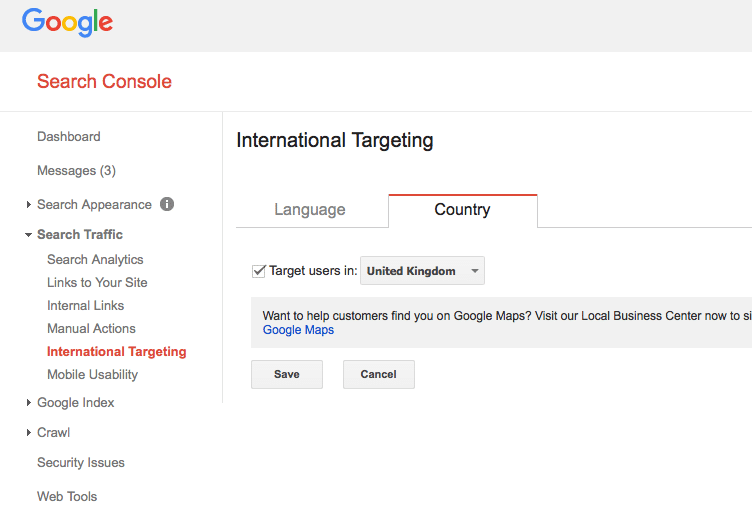
Setting a location preference for your blog can make a huge difference to your audience targeting.
You also want to think about your angles for promotion.
People tend to do a fair bit of research before travelling somewhere new — making it the perfect opportunity for you to win fans and customers throughout the entire buying cycle.
Putting yourself in the shoes of someone that wants to book a holiday is a powerful way to find untapped keyword opportunities for your affiliate site.
From solo female travellers to digital nomads and dads booking holidays for the whole family.
These people all have unique preferences and requirements, so will be searching for different things before they travel.
Promoting Travel Affiliate Programs On Your Blog
Want to know the secret to affiliate marketing?
Focus on promoting products that people already want. Find your hungry market, understand your customer’s problem better than they do themselves and sell with ease.
Quality products competitively priced convert best.
Bloggers promote travel offers in a variety of ways like:
Embeddable Interactive Widgets
These little beauties are popular among travel blogs and other relevant travel sites. They’re widgets that you can embed into your website content, and allow easy checking for cheap flights straight from your blog.
Like this one:

Some sites place these in between sections of their content if it’s relevant, others place it right at the end of their posts. Useful for saving visitor time and providing a faster way for them to check flight and hotel deals.
Contextual Links
The classic way of referring readers to other websites. A contextual link is a link placed in the body of your content, like this link to our financial freedom post.
Linking out like this is still one of the most effective ways to increase referral traffic to other websites. Travel blogs typically link out from keywords like “travel insurance” and “rental cars” to relevant offers.
Building Your List
Email marketing is hands-down one of the most powerful ways to indirectly monetise your website.
Building your email list involves offering something of value in exchange for your reader’s email address. It’s called a “lead magnet“. Lead magnets range from free white-papers and ebooks to product discounts and free trials.
Marketing through email is unique because you can nurture leads by following up with relevant content. Many travel affiliate programs run special offers and exclusive deals that you can promote to your list.
If you’re looking for a tool, check this piece on the best email marketing services.
Banners and Sidebars
Another way you can promote offers are through banner ads and sidebars. They aren’t as effective as they used to be but can still work well if used strategically.
Finding the Best Travel Affiliate Programs
A few minutes of research led me to hundreds of travel affiliate programs!
But finding the best affiliate offers to promote is relative to your situation. We all have different criteria for what defines “best“.
It also depends on your industry angle. Many travel bloggers cover a broad range of things related to the travel industry and will be looking to promote a similarly broad range of products and services.
The programs you’ll see listed on websites like this one will only ever show you a small fraction of affiliate programs out there, so it’s useful to know how to run searches yourself.
Here’s a neat way to find travel affiliate programs:
Brainstorm the travel plans your readers have in their minds.
For example, if your readers are into adventure travel, you’ll want to search for affiliate programs relating to things like skydiving, paragliding and surfing.
An excellent example is the 20 Things To Do In Oahu Hawaii post on the popular Y Travel blog.
They cover some fun things to do in Oahu and link to the tour companies that run these excursions (walking tours and surfing lessons in this case). They also link out to rental car companies, hotels and restaurants.
Contextual affiliate links galore without being sleazy or spammy!
Viator is a sister company of Trip Advisor that specialises in travel excursions. And you guessed it, they have an affiliate program.
These guys are the world leader when it comes to anything experience or excursion. They have thousands of attractions, tours and experiences that people book through their website.
Some of these tours are priced at hundreds of dollars per person. And they’re selling like hotcakes…
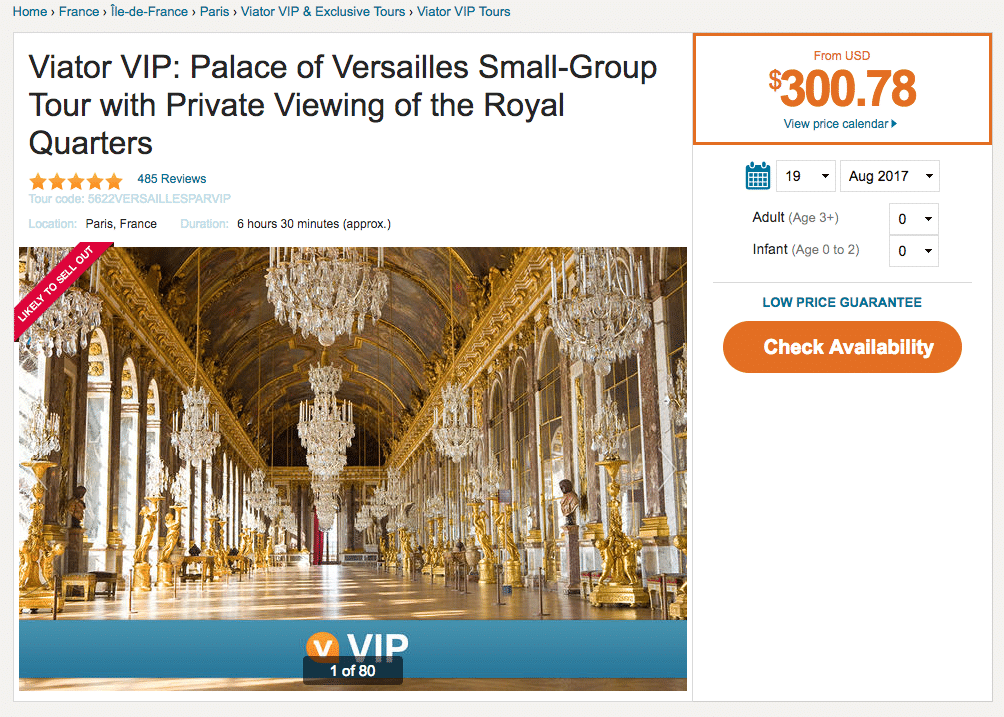
Check out the number of reviews they have on this palace group tour.
These are all things that you can promote through your travel blog.
Using Boolean Search Operators
Boolean search operators are modifiers we use to find specific things in search engines.
Use these modifiers to find relevant affiliate programs:
- [destination] + [surfing] + affiliate program
- [destination] + [attraction/experience] + affiliate program
- [destination] + [hotels] + affiliate program
An Easier Way to Find Travel Affiliate Programs
While it’s useful to know how to find the best affiliate programs yourself, for the majority of affiliates, you can’t go wrong with well-known affiliate networks.
The likes of CJ Affiliate (Commission Junction), ShareASale, Rakuten Linkshare and AWIN have hundreds of affiliate programs in the travel industry. These affiliate networks are great because you can see how programs stack up against each other.
Filtering the best-performing ones that align with your preferences is the way to go.
Travel Affiliate Programs with the Highest Earnings
I signed up to CJ Affiliate and discovered that they have 345 affiliate programs in the travel industry alone!
For the purpose of this article, I sorted the programs in order of best performance and I’ll be sharing some of them here.
Performance of programs on CJ Affiliate is measured using two metrics. EPC and Network Earnings.
EPC (Earnings Per Click)

CJ Affiliate uses a seven day as well as a three month EPC to help measure the performance of affiliate programs on their platform. The EPC is the average earnings per 100 clicks that go through to a merchant website.
They work it out by converting each partner’s total commissions into USD, then dividing by the total number of clicks they’ve received, and finally multiplying by 100.
This gives them the average earnings per 100 clicks.
EPC gives you a rough of idea of the commissions you can expect per 100 referred visitors.
The three month EPC is calculated using data obtained over the previous five months. A three month EPC in July will have come from data collected in February, March and April. This is all for the sake of accurate data. They leave a two-month gap to take refunds and extended transactions into account.
The three month EPC provides the most accurate “best guess” of earnings you can expect to receive per 100 visitors sent to a merchant offer.
Network Earnings
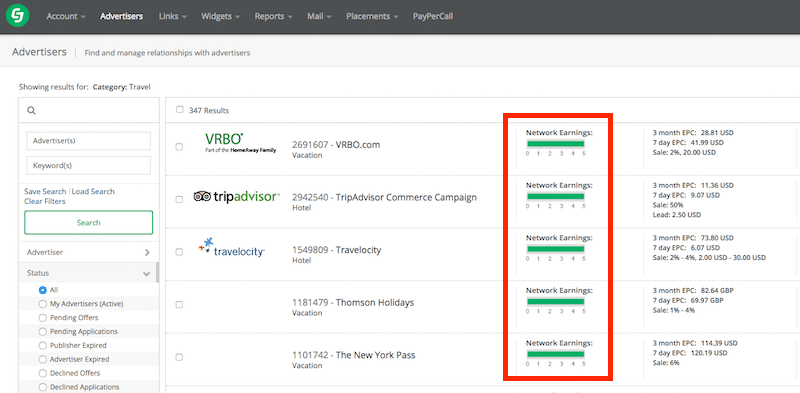
The second metric CJ uses is Network Earnings. This is a rating used to compare how merchants stack up against each other based on the amount of commissions paid out to affiliates. The ranking is based on monthly account performance.
The ratings are based on a scale from zero to five bars. For this article, I’ve only selected affiliate programs with a rating of four and above. So each merchant listed here happens to be in the top 20% in terms of commissions paid out to affiliates.
The following merchants have paid out the most in commissions to affiliates over the last month on CJ Affiliate.
Ordered from higher to lower:
VRBO.com
This is the top performer for CJ Affiliate in the travel industry. They’re one of the worlds leading online marketplaces for vacation rentals. People host their holiday homes on their site for holidaymakers to rent out.
VRBO charges customers an 8% booking fee per listing or an annual fee of $399 for unlimited listings. With 20% commissions on annual subscriptions, you’re looking at $80 commissions per referral.
Decent!
Commission Structure:
- $28.83 three-month EPC.
- 20% commission on new owner annual subscriptions.
- $20 commission when new owners list their home for free.
- 2-3% commission on online bookings requests.
Trip Advisor

A mammoth in the travel industry with an equally comprehensive affiliate program. Trip Advisor offers Pay-per-lead programs for vacation rentals. They pay $2.50 per qualified email to property owners.
They also have a “Commerce Clicks” offer that pays 50% commissions. Commerce clicks is when users sent from your website click on commerce links or ads throughout the Trip Advisor site (It’s a little confusing).
Commission Structure:
- $11.35 three-month EPC
- $2.50 per qualified vacation rental lead
- 50% commission on commerce campaign clicks
Travelocity
A comparison site where you can book almost anything that relates to travel. They do flights, hotels, cruises, car rentals and much more.
Commission structure:
- $72.51 three-month EPC
- 6% commission on pre-paid hotels.
- 3% on pay after stay hotels.
- 2% car rentals
- 3% vacation package.
- 45-day cookie.
Thomson holidays
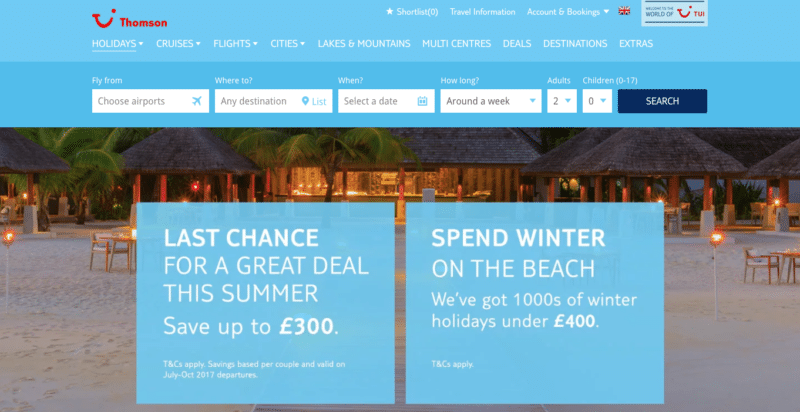
The UK’s largest supplier of package holidays. Thomson has established a powerful brand and is one of the most visited travel websites in the UK. They offer 2% commission on all package and beach holiday bookings. You’ll earn an average of $45 per booking.
Commission structure
- $107.13 three-month EPC.
- 2% on package and beach holidays.
- 4% on hotels.
- 2% on cruises.
- 1% on flights.
- 14-day cookie.
The New York Pass
A popular sightseeing card that offers free entry to many popular tourist attractions in New York. Over 50 million tourists visit New York every year so plenty of earning potential. Product enjoys high conversion rates of 3% with an average order size of over $500.
Commission structure:
- $114.39 three-month EPC.
- 6% on pass sales.
- 45-day cookie.
Seaworld Parks
A huge theme park and entertainment brand based in Orlando, Florida. Seaworld is globally recognised for their theme park rides and controversial captive breeding of killer whales and dolphins. Love them or hate them, they have an affiliate program that’s doing really well.
Commission structure:
- $29.24 three-month EPC
- 4% on Seaworld, Discovery Cove, Busch Gardens and Sesame Place ticket sales.
- 2-day cookie.
Sandals & Beaches Resorts
All inclusive vacations, honeymoons and weddings in the Caribbean. They have fifteen Sandals and three beach resorts that are very well-known to people who’ve spent time in the Caribbean. Guests usually stay for a week, which means more commission for you.
Commission structure:
- $54.73 three-month EPC.
- 4% on each completed stay.
- 60-day cookie.
Priceline.com
Comprehensive travel comparison website offering flights, hotel rooms, cruises, car rentals and more. Priceline is a trusted brand that generates over 2.9 million organic search visits to their site every month.
Commission structure:
- $71.72 three-month EPC.
- 3% on hotels, rental cars and express deal flights.
- 3% on cruises and vacation packages.
- 30-day cookie.
IHG
An international hotel company with over 5000 hotels in 100 countries. A huge brand that generates over 3.6 million organic visits to their site every month. They’re partners with some of the leading hotel chains in the world. Working with the likes of Intercontinental, Crowne Plaza and Holiday Inn.
Commission structure:
- $71.59 three-month EPC.
- 3% on completed hotel stays
- 14-day cookie.
Polynesian Cultural Centre
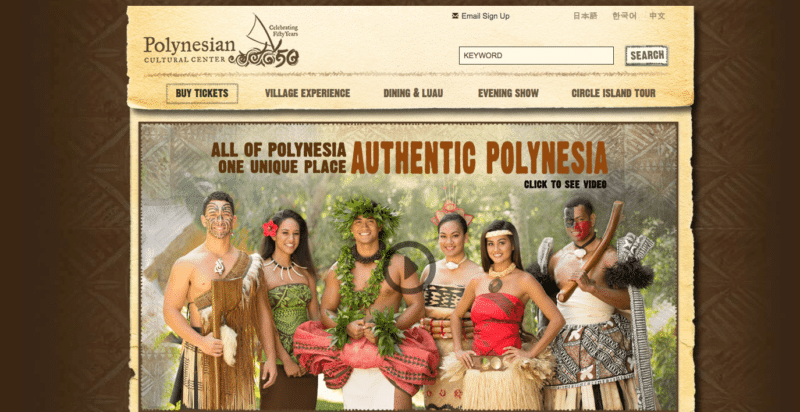
The Polynesian Cultural Center is Hawaii’s number one paid attraction. It’s situated on the north shore of Oahu and consists of 42 acres of spectacular beauty. It has won awards for being the favourite visitors’ attraction in Hawaii.
On top of selling tickets to the various tours they offer, they also have their own e-commerce store where you can earn affiliate commissions. Pretty cool!
Commission structure:
- $120.66 three-month EPC
- 5% commission on tour sales on polynesia.com
- 7% commission on qualified products from shop.polynesia.com
- 30-day cookie.
G Adventures
The world leader when it comes to all things adventure travel. G Adventures offers a generous 90-day cookie. The average online order value is $2600. Huge range of trip pricing from $500 all the way up and beyond $12,000.
Commission Structure:
- $55.92 three-month EPC.
- 5% on travel packages booked online.
- 90-day cookie.
Rounding Things off
The travel industry is booming with opportunities for affiliates. While the big brands dominate many of the high-volume keywords in the search engines, a quick two-minute search uncovered some keywords with great potential.
Any website that produces a steady stream of passive income is worth a lot in the domain marketplace. And it shouldn’t be too difficult to build an affiliate site that produces passive income in just a few months.
Finding the right products, keywords and audience combined with a powerful content marketing and SEO strategy will set you up for a thriving affiliate site in the travel industry.

I’m a London-born lover of technology, obsessed with online business, passive income and the digital economy. I love learning, researching and curating the most valuable resources to save you time, money and help you discover the truth on what it actually takes to achieve your goals.



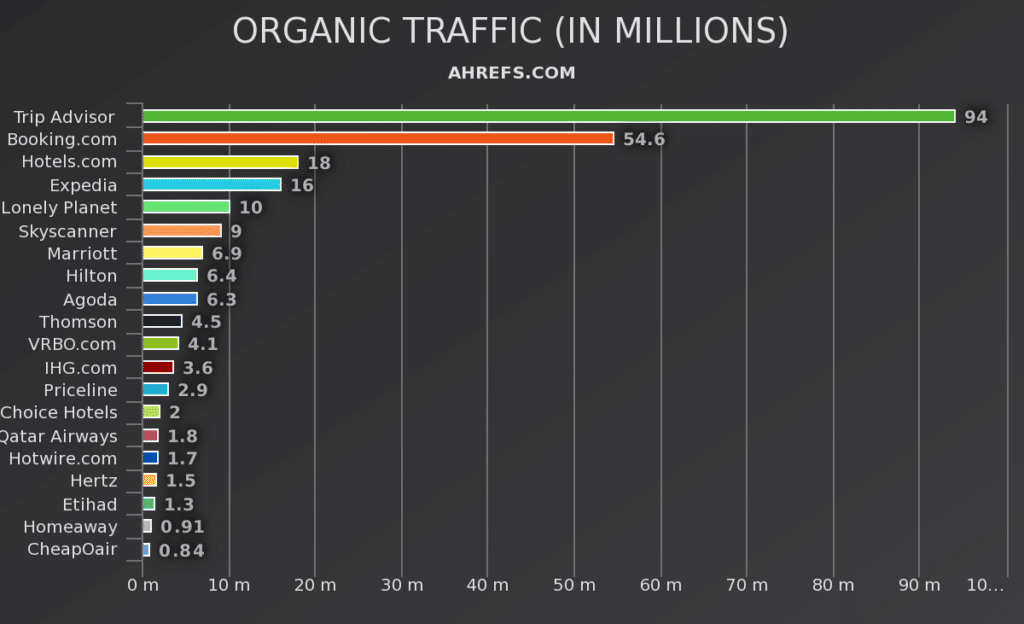






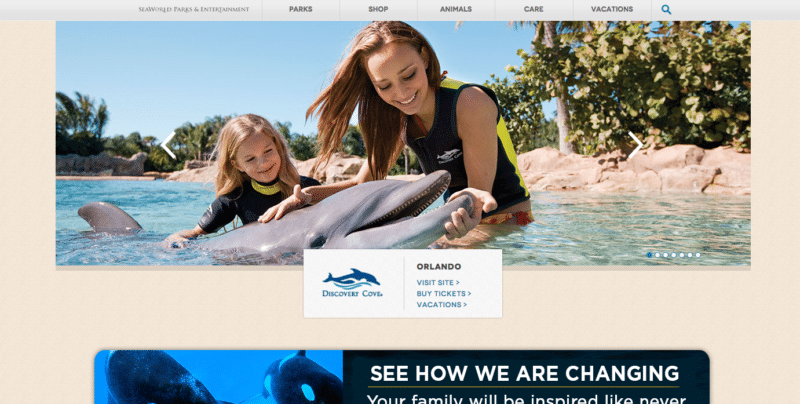
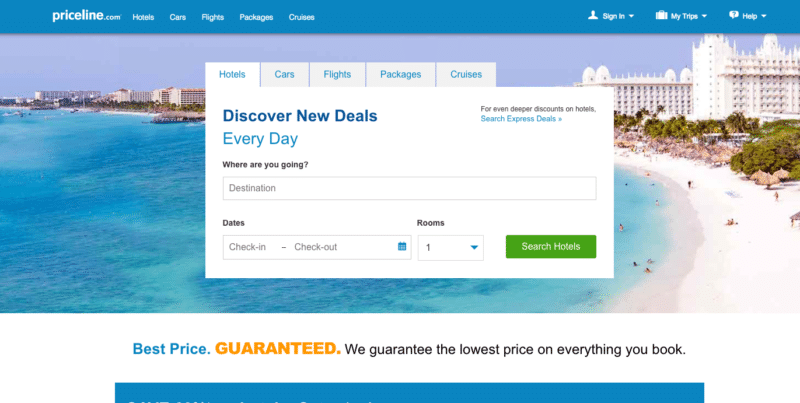
Thank you so much for this blog. This will really help me in my travel blog. I will take the time to go over this post. Great post
Hey Josephine, thank you for your kind words, I hope it’ll help you build a thriving travel blog :-)
How do you turn a travel site into a site that attracts affiliates. We want to offer $75-$125 per sale on a $399 sale.
great post to earn affiliate from these websites. Nice article.
I have to say…. this is the second post that I read by you regarding affiliates and I really feel like I hit the jackpot. I learned more in those 2 posts than months of researching. Thank you for this.
Wow, thanks so much Heather. I’m delighted that you found these posts valuable! I like to put myself in the readers shoes when I’m researching for a post — helps me cover a lot in terms of common questions, misconceptions…etc.
Great article and has me motivated. Although I have a good start on IG my blog doesn’t seem to get any traffic. I have some ideas now, because of your article, but I am not sure how to get the links on my blog. For instance, if I do San Diego for wheelchairs, how do I get a link to hotels, Trip Advisor or wheelchair rentals. I have blogger and it doesn’t seem as user friendly as Word Press but not able to change just yet. Any help would be great.
Hey Bonnie, Blogging is really tough. You don’t just start getting traffic like that. There are a variety of methods you can employ to start getting traffic, SEO being one of them, which relates to your link building questions. Getting links to those types of pages require a good dose of creativity. You’ll want to reach out to people that write content on similar topics and introduce your piece for inclusion. Your outreach emails needs to be fun, engaging and unique. And you need to have a way of discovering blogs that write about certain topics that relate to the… Read more »
Thank you for this list! There some offers that I haven’t seen before.
I also noticed that most of the programs here are quite small. And that Travelpayouts is missing from the list. Travelpayouts is my favorite travel affiliate to work with. On their website I can join a lot of affiliate programs like Booking, Kiwi, Klook, RailEurope, RentalCars, and so on. And Travelpayouts has good commission rates and their cookies live for 30 days.
I think it would be useful for others if you added it to the list. But either way, thnk for your work!
Thank you so much for this article. Very useful information in there. Great post